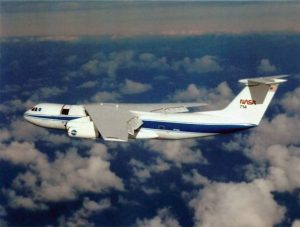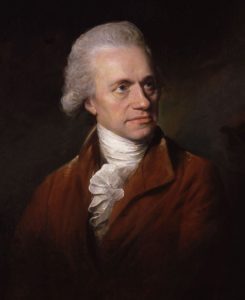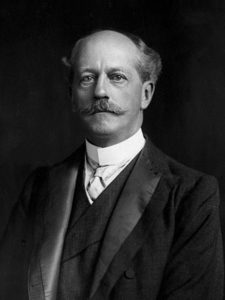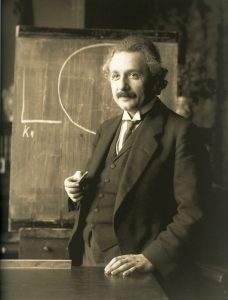
Photo: Percival Lowell sits in the Clark Telescope Dome | Lowell Observatory Archives
March 10, 1977: Rings of Uranus discovered

The Kuiper Airborne Observatory in flight | NASA
The rings of Uranus were discovered by astronomers James L. Elliot and Edward W. Dunham, and software developer Jessica Mink on March 10, 1977. Though British astronomer William Herschel also reported observing rings in 1789, modern astronomers argue that the rings were too faint to be seen using the technology available at the time. The discovery was made using the Kuiper Airborne Observatory (KAO), a highly modified Lockheed C-141A Starlifter jet transport aircraft. The discovery team was using an occultation* of the star SAO 158687 to study Uranus’s atmosphere when they noticed that the star momentarily disappeared from view 5 times before and after the planet eclipsed it, leading them to conclude that Uranus had 5 rings.
[vcex_divider color=”#dddddd” width=”100%” height=”1px” margin_top=”20″ margin_bottom=”20″]
*An event that occurs when one object is hidden by another object as it passes through the observer’s view.
March 13
– 1781: William Herschel Discovers Uranus

William Herschel | Lemuel Francis Abbott
On March 13, 1781, German-born British astronomer and composer William Herschel discovered the planet Uranus while searching for double star systems. He initially believed it to be a comet or a circumstellar disk,* but a computation of its orbit by Russian Academician Anders Lexell confirmed that it was most likely a planet.
Herschel named the object he had discovered “Georgian star,” after King George III. However, name was unpopular (particularly in France) and it was often simply referred to as “Herschel” until the name “Uranus” was adopted later on. In Greek mythology, Uranus is the god of the heavens and the father of the Titans.
[vcex_divider color=”#dddddd” width=”100%” height=”1px” margin_top=”20″ margin_bottom=”20″]
* A ring-shaped accumulation of matter composed of gas, dust, planetesimals, asteroids, or collision fragments in orbit around a star.
– 1855: Percival Lowell is born

Percival Lowell | Lowell Observatory Archives
American businessman, author, mathematician, astronomer, and Lowell Observatory founder Percival Lowell was born in Boston, Massachusetts on March 13, 1855. He is best known for his tireless search for what he referred to as Planet X, a trans-Neptunian object that he believed to be the ninth planet in our solar system. Born to a prominent family of the Boston Brahmins (Boston’s traditional old upper class), he earned a degree in mathematics from Harvard University and spent much of his post-college life traveling through Korea and Japan.
Upon his return to the U.S., Lowell became interested in studying Mars—particularly the “canals” drawn by Giovanni Schiaparelli, an Italian astronomer and director of the Milan Observatory. He chose Flagstaff, Arizona as the location for the observatory he planned to build, and the rest is history!
– 1930: The discovery of Pluto is announced to the world
Pluto, Percival Lowell’s fabled Planet X, was discovered by Clyde Tombaugh on February 18, 1930. The discovery wouldn’t be announced until the following month on March 13, as the observatory felt it would be fitting to make the announcement on Percival’s birthday, as well as the day that William Herschel discovered Uranus in 1781.

Albert Einstein during a lecture in Vienna in 1921 | Ferdinand Schmutzer
March 14, 1879: Albert Einstein is born
German-American theoretical physicist Albert Einstein was born on March 14, 1879, in the city of Ulm, located in what is now Baden-Württemberg, Germany. Einstein is best known for developing the theory of relativity (from which his world-famous E=mc2 mass-energy equivalence formula arises) and is widely considered to be one of the greatest physicists of all time. He is also credited with making important contributions to the development of the theory of quantum mechanics.